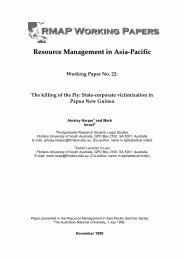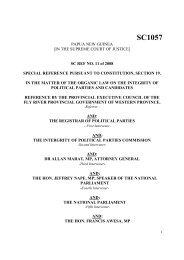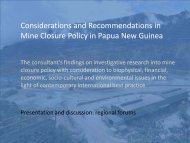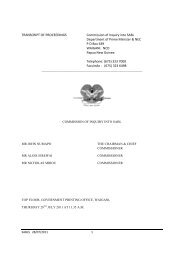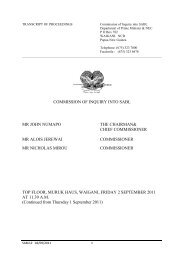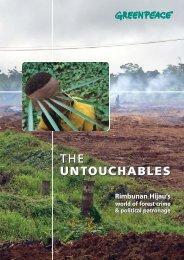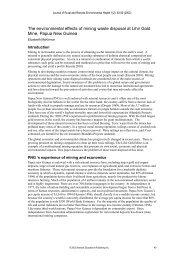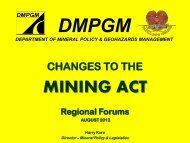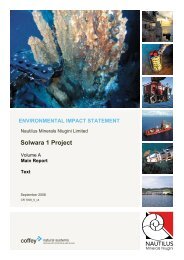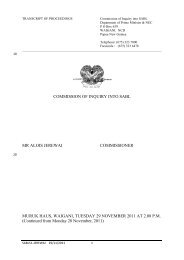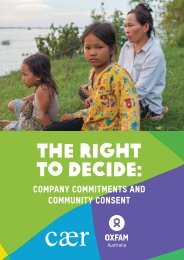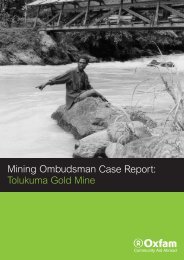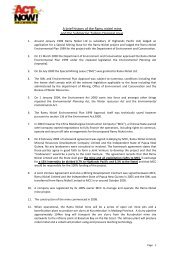Fishy business. The Social Impact of SST.pdf - Act Now!
Fishy business. The Social Impact of SST.pdf - Act Now!
Fishy business. The Social Impact of SST.pdf - Act Now!
You also want an ePaper? Increase the reach of your titles
YUMPU automatically turns print PDFs into web optimized ePapers that Google loves.
Multi-group landowners meeting:21 July 05, Saure #2 clan members/councilors, Wewak islands Fisheries Association,Murik Resource Owners, Hawain Resource Owners, Schouten Islands Resource Owners.<strong>The</strong>re was an agreement with Saure #2 landowners when work on the <strong>SST</strong> project was initiatedat Yawasoro by Francis Sumanap and Joachim Nianguma. Both Sumanup and Niangumaassured them that everything would be okay as long as the landowners did their part. <strong>The</strong>y werepromised big development with many spin<strong>of</strong>fs by Kevin Conrad, too. So the leaders <strong>of</strong> the 8clans were urged to fast-track registration <strong>of</strong> company and other necessary documentation withBaltazar Kaprangi.Islands Chairman, Nick Artekain: I was involved from the start: “I did not see any clause in theagreement stating benefits to locals in PNG. <strong>The</strong> agreement was only for the benefit <strong>of</strong>politicians and foreigners.”Concerns <strong>of</strong> the agreement include:• Use <strong>of</strong> grease to lure resource owners to sign.• Use <strong>of</strong> company name/documentation to start project and then a shift to anotherlocation.• Non compliance with laws protecting resource owners’ rights in major developmentprojects.• Suare Villagers spent substantial amounts <strong>of</strong> money and effort in getting the licenseagreement in place but have not received any benefits in return.• Ownership <strong>of</strong> the loinery project.Though the landowners <strong>of</strong> Saure, Wewak Islands and others were involved in the initial stages<strong>of</strong> the project, they never actively participated in its planning and/or formulation. To makematters worse, the project site was move to its current location and even after heavyinvolvement from Sauire landowners. Landowners were never included in the contract. As onelandowner from Wewal islands stated, “<strong>The</strong>re is no clause in the agreement that includeresource owners.” According to the resource owners the project is owned by Somare and sonsand the building is owned by Sir Peter Lus.Somare also promised Nick Artekain <strong>of</strong> the ESIA to assist in developing their projects, Artekainreports Kinson Kare was there too, and Somare <strong>of</strong>fered 1 million kina to ESIA-- but thenreneged. <strong>The</strong>y believe this money was then given to Sir Hugo. Arthur Somare and Narokobisigned the project agreement., but the resource owners do not have a stake in the project. “Whydid Somare and Narokobi the pillars <strong>of</strong> Sepik society and the State <strong>of</strong> PNG with their respectivegovernment Ministers and Department Heads sign the agreement knowing that the rights <strong>of</strong> theresource owners were not protected?” “What’s Hugo’s role I all this?”According to locals the fishing ships usually discharge dirty oil between Kairiru and Vokeoislands. <strong>The</strong>re have been sightings <strong>of</strong> ‘waste matter’ in the sea believed to be from theloinery.<strong>The</strong> use <strong>of</strong> sophisticated modern fishing methods in local waters between the WewakEast Coast and the Shouten Islands include drag nets, fishing attraction devices (lights) andradar. As a result the fish stock in traditional fishing waters has been dramatically depleted andlocal fishermen now have to travel further out to catch the same fish. Evidence <strong>of</strong> floaters andlong line nets are at Bien island. Photos were apparently taken by the Environmental LawCentre.122



